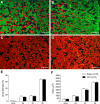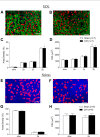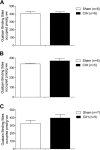Diaphragm muscle remodeling in a rat model of chronic intermittent hypoxia
- PMID: 23640977
- PMCID: PMC3707358
- DOI: 10.1369/0022155413490947
Diaphragm muscle remodeling in a rat model of chronic intermittent hypoxia
Abstract
Respiratory muscle remodeling occurs in human sleep apnea--a common respiratory disorder characterized by chronic intermittent hypoxia (CIH) due to recurrent apnea during sleep. We sought to determine if CIH causes remodeling in rat sternohyoid (upper airway dilator) and diaphragm muscles. Adult male Wistar rats were exposed to CIH (n=8), consisting of 90 sec of hypoxia (5% at the nadir; SaO₂ ~80%)/90 sec of normoxia, 8 hr per day, for 7 consecutive days. Sham animals (n=8) were exposed to alternating air/air cycles in parallel. The effect of CIH on myosin heavy-chain (MHC) isoform (1, 2a, 2x, 2b) distribution, sarcoplasmic reticulum calcium ATPase (SERCA) isoform distribution, succinate dehydrogenase activity, glycerol phosphate dehydrogenase activity, and Na⁺/K⁺ ATPase pump content was determined. Sternohyoid muscle structure was unaffected by CIH treatment. CIH did not alter oxidative/glycolytic capacity or the Na⁺/K⁺-ATPase pump content of the diaphragm. CIH significantly increased the areal density of MHC 2b fibers in the rat diaphragm, and this was associated with a shift in SERCA proteins from SERCA2 to SERCA1. We conclude that CIH causes a slow-to-fast fiber transition in the rat diaphragm after just 7 days of treatment. Respiratory muscle functional remodeling may drive aberrant functional plasticity such as decreased muscle endurance, which is a feature of human sleep apnea.
Keywords: chronic intermittent hypoxia; diaphragm dysfunction; myosin heavy chain isoform distribution; obstructive sleep apnea; respiratory muscles.
Conflict of interest statement
Figures







Similar articles
-
Reactive oxygen species mediated diaphragm fatigue in a rat model of chronic intermittent hypoxia.Exp Physiol. 2014 Apr;99(4):688-700. doi: 10.1113/expphysiol.2013.076828. Epub 2014 Jan 17. Exp Physiol. 2014. PMID: 24443349
-
Chronic hypoxia increases rat diaphragm muscle endurance and sodium-potassium ATPase pump content.Eur Respir J. 2011 Jun;37(6):1474-81. doi: 10.1183/09031936.00079810. Epub 2010 Dec 9. Eur Respir J. 2011. PMID: 21148231
-
Respiratory control and sternohyoid muscle structure and function in aged male rats: decreased susceptibility to chronic intermittent hypoxia.Respir Physiol Neurobiol. 2012 Mar 15;180(2-3):175-82. doi: 10.1016/j.resp.2011.11.004. Epub 2011 Nov 22. Respir Physiol Neurobiol. 2012. PMID: 22122888
-
Early life exposure to chronic intermittent hypoxia causes upper airway dilator muscle weakness, which persists into young adulthood.Exp Physiol. 2015 Aug;100(8):947-66. doi: 10.1113/EP085003. Epub 2015 Jul 14. Exp Physiol. 2015. PMID: 26096367
-
Sternohyoid and diaphragm muscle form and function during postnatal development in the rat.Exp Physiol. 2013 Sep;98(9):1386-400. doi: 10.1113/expphysiol.2013.073346. Epub 2013 May 24. Exp Physiol. 2013. PMID: 23709586
Cited by
-
[Lowered sarcoendoplasmic reticulum calcium uptake and diaphragmatic SERCA1 expression contribute to diaphragmatic contractile and relaxation dysfunction in septic rats].Nan Fang Yi Ke Da Xue Xue Bao. 2016 Apr 20;37(4):438-443. doi: 10.3969/j.issn.1673-4254.2017.04.03. Nan Fang Yi Ke Da Xue Xue Bao. 2016. PMID: 28446393 Free PMC article. Chinese.
-
Metabolic dysregulation and decreased capillarization in skeletal muscles of male adolescent offspring rats exposed to gestational intermittent hypoxia.Front Physiol. 2023 Jan 12;14:1067683. doi: 10.3389/fphys.2023.1067683. eCollection 2023. Front Physiol. 2023. PMID: 36711021 Free PMC article.
-
Ultrasonographic changes and impact factors of diaphragmatic function in patients with obstructive sleep apnea-hypopnea syndrome.Sleep Breath. 2024 Jun;28(3):1319-1327. doi: 10.1007/s11325-024-03010-7. Epub 2024 Feb 28. Sleep Breath. 2024. PMID: 38413555
-
Chronic Intermittent Hypoxia-Induced Diaphragm Muscle Weakness Is NADPH Oxidase-2 Dependent.Cells. 2023 Jul 12;12(14):1834. doi: 10.3390/cells12141834. Cells. 2023. PMID: 37508499 Free PMC article.
-
Structure and Function of the Mammalian Neuromuscular Junction.Compr Physiol. 2022 Aug 11;12(4):3731-3766. doi: 10.1002/cphy.c210022. Compr Physiol. 2022. PMID: 35950651 Free PMC article.
References
-
- Allen DG, Lamb GD, Westerblad H. 2008. Skeletal muscle fatigue: cellular mechanisms. Physiol Rev. 88:287–332 - PubMed
-
- Aubier M, Viires N. 1998. Calcium ATPase and respiratory muscle function. Eur Respir J. 11:758–766 - PubMed
-
- Aughey RJ, Gore CJ, Hahn AG, Garnham AP, Clark SA, Petersen AC, Roberts AD, McKenna MJ. 2005. Chronic intermittent hypoxia and incremental cycling exercise independently depress muscle in vitro maximal Na+-K+-ATPase activity in well-trained athletes. J Appl Physiol. 98:186–192 - PubMed
-
- Baldwin KM, Haddad F. 2002. Skeletal muscle plasticity: cellular and molecular responses to altered physical activity paradigms. Am J Phys Med Rehabil. 81:S40–S51 - PubMed
-
- Bradford A. 2004. Effects of chronic intermittent asphyxia on haematocrit, pulmonary arterial pressure and skeletal muscle structure in rats. Exp Physiol. 89:44–52 - PubMed
Publication types
MeSH terms
Substances
LinkOut - more resources
Full Text Sources
Other Literature Sources
Research Materials
Miscellaneous

